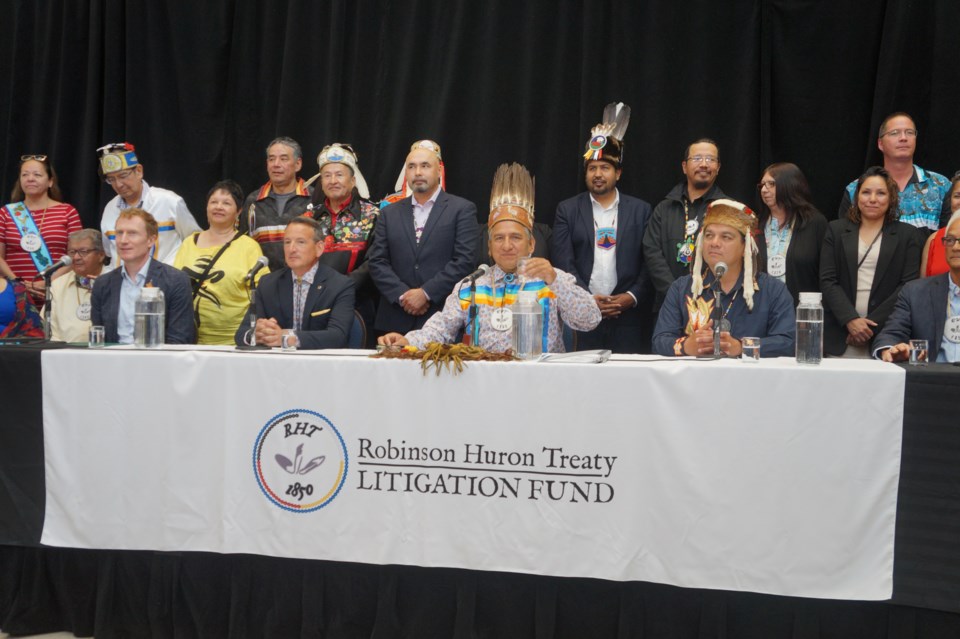After the historic announcement June 17 of a proposed $10-billion settlement between Canada, Ontario and the Indigenous beneficiaries of the Robinson Huron Treaty, Marc Miller, the Crown-Indigenous affairs minister, said it would be a game-changer for the communities.
“People will have many views about this. What I do think they need to understand is this is about the treaty partner, Canada and Ontario, paying its bills.
“Even a past-due library book would cost a small fortune if it took 173 years to pay late fees.”
As to how the government would have the First Nations use the funds, Miller said, "I would venture to say that it is not up to Canada or Ontario to dictate the terms on which the monies are used.”
Atikameksheng Anishnawbek Gimaa (chief) Craig Nootchtai is excited, but told Sudbury.com the amount doesn’t reflect the true value.
The proposed settlement is for past revenue losses in relation to the Robinson-Huron Treaty, signed in 1850, which promised its Indigenous beneficiaries annual payments in exchange for the right to use their lands. An augmentation clause in the treaty promised annual payments tied to any resource revenues, including mining and forestry and harvesting rights.
However, those rates have not changed since 1874, despite billions in revenue from the land resources.
In 2018, the Ontario Superior Court of Justice ruled that the Crown had a duty to increase annual payments to the 21 First Nation beneficiaries of the Robinson-Huron Treaty. It is payment for past resources that the province and federal government have been negotiating, after a decade in the courts.
It’s a proposed settlement that is long overdue, said Miller, and a “major milestone as we renew treaty relationship and ceremony in the way it was intended to be. We want to recognize that the crown did not fulfill its treaty promises,” he said.
Ontario’s Indigenous Affairs Minister, Greg Rickford, said it was an attempt to reconcile the past in what was “the best way, perhaps the only way, in modern times,” adding that the proposed settlement is also a commitment to the First Nations that “it won’t take 173 years to deal with in the future.”
He celebrated the resilience of the Indigenous treaty members, and the litigation team leaders for putting together “the template for what would form a relationship that I believe is lasting, was done in the right way, and holds the promise of a great future.”
The Robinson Huron litigation team's lawyer, David Nahwegabow, told Sudbury.com that any litigation is on hold for now. “At this point in time, part of the proposed settlement agreement is that litigation will be suspended."
While there is still the matter of the “go-forward implementation of the augmentation clause,” that is, any future payment of resources, “there is a non-binding legal commitment, political commitment, to engage in those go-forward negotiations.”
Nootchtai, chief of Atikameksheng Anishnawebek, one of the 21 Robinson Huron First Nations, is the great-great-great grandson of Shingwaukonse, the leader, treaty negotiator and one of the original signatories of the Robinson Huron Treaty.
Nootchtai told Sudbury.com that while it is exciting to come to “some kind of amount,” he doesn’t feel it reflects the true amount they are entitled to.
“It really doesn't match what we should be getting, but it's definitely a good start to really help our communities move forward,” he said after the announcement.
Noting that it is just the start of many discussions to be had, he said his focus is “how we're going to distribute these funds to make sure that the money is not only used today, but for future generations.”
Atikameksheng Anishnawbek is also in the courts for a land claim at present.
In 1850, the lands of the Atikameksheng Anishnawbek lay between Vermillion River in the west, Wahnapitae River in the east, seven miles inland from the north shore of Lake Huron, up to Lake Wahnapitae, and this is the boundary now claimed.
Nootchtai said the treaty negotiations have caused him sleepless nights and cost time with his family, but that it’s been a journey of personal growth as well. “I've learned more, not only the treaty history, but the history of my community,” he said.
He said he routinely reads social media sites and sees a mix of emotions from his community.
“Some are saying, ‘This is such a great day, and we need to celebrate,’ and I feel that way, too,” he said. “But then there's some that say they (the Crown) are still maybe not as trustworthy.”
He said, “We're all excited, but we're all kind of nervous at the same time and anxious to see how we're going to use this money to benefit the children, at the same time honouring our ancestors who've worked so hard to get here.”
He said the complexity of the situation means it will be years before they know what the go-forward calculation will be, “but it's a good start. So I'm happy for that.”
Jenny Lamothe is a reporter with Sudbury.com.




